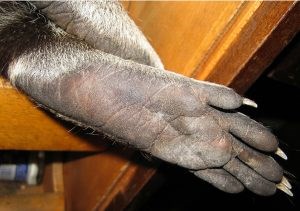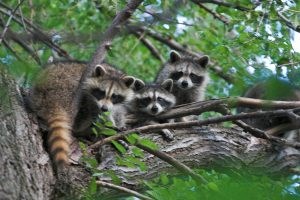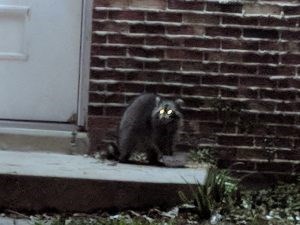This content was originally published by the Longmont Observer and is licensed under a Creative Commons license.
Trash pandas, ring-tailed bandit, bearcoon. Whatever you choose to call them, raccoons are everywhere in the city. Whether you consider them cute or a nuisance, they are a fact of city life. The first person to write about raccoons was Christopher Columbus. They are smarter than cats and just under monkeys on the IQ scale.
Raccoons belong in the family Procyonidae which is closely related to the bear family. At one time, raccoons were part of the bear family, but then scientists gave them their own family. Now they are in the same family as red pandas and coatis. The scientific name for raccoon is Procyon lotor which literally means “washer dog,” a reference to their habit of dipping their food in water. The word “raccoon” is derived from an Algonquin word (arakun) that means “he scratches with hands.”
Raccoons are about three feet long which includes their 12-inch bushy tail. Adults can weigh between 15 and 40 pounds, depending on genetics and the environment. Urban raccoons tend to weigh more than their rural counterparts because of the ready availability of food, and males are typically larger than females. Raccoons are greyish-black in color and they have a distinctive black mask around the eyes and four to ten rings around the tail. One theory about the mask that raccoons have around their eyes is that it may help to deflect glare which helps raccoons see better in the dark. Raccoons have a hunched appearance due to the fact that their hid legs are longer than their front legs.

Their paws have five toes that are very nimble which allows them to manipulate their food. In fact, the front paws are so nimble that they are capable of unlatching cages and unlacing shoes. In addition, raccoons can rotate their hind feet 180 degrees which allows them to climb down trees head first.
Raccoons are omnivorous and will eat a wide variety of foods. In non-urban settings, raccoons eat a lot of food items found in and near water such as crayfish, clams, frogs, fish and snails. They also eat insects, bird eggs, fruits, vegetables and seeds. In urban settings, raccoons will also eat garbage and pet food. Raccoons are generally not good at hunting, but will sometimes catch small mammals such as mice. Although typically solitary, raccoons will eat together when there is a large food source. As an aside, a group of raccoons is called a nursery. Many people are familiar with the habit of raccoons “washing” their food. Raccoons have highly sensitive touch and it is thought that this sensitivity increases under water, giving the raccoon more information about the food it is eating.
Female raccoons, or sows, are sexually mature at 8-12 months of age. Males, or boars, take longer to mature and are sexually mature at around two years of age. Mating season lasts from February to June although most of the mating occurs in March. Males will expand their territories during mating season to have access to more females. Raccoons have a promiscuous mating system and the males and females do not associate once mating has occurred.

Females typically give birth in dens located in trees. There is only one litter per year ranging from three to seven young (or kits) with the average being four. Kits are born blind and their eyes do not open until around 18-24 days of age. Females often move their young to a new den a few weeks after birth which can sometimes lead to people finding baby raccoons they think are abandoned. If the young are left alone, the female will return to finish moving her young. The mother weans the kits around 70 days of age. By the time the kits are 20 weeks old, they will forage with their mother. They will continue to stay with the mother in her den throughout the first winter. The following spring, the young will disperse, but many will den near their mother’s den. The average lifespan of a raccoon in the wild is two to three years, although they may live up to 16. They are preyed upon by hawks, wolves, and coyotes.
Raccoons are nocturnal animals and are usually not active during the day. They are solitary animals with home ranges of about a half mile to three miles in diameter. When it is extremely cold, raccoons are not active although they do not actually hibernate. During these times they live off their fat reserves losing up to 50% of their body weight. As already mentioned, raccoons are excellent climbers. What you may not know is that they are also strong swimmers, although they may not prefer to swim. Raccoons don’t have waterproof fur, so swimming adds weight to their bodies. They can also run up to 15 miles per hour, and have been known to fall up to 40 feet without injury. Raccoons have a good sense of hearing and excellent night vision.

Because raccoons are so adaptable, they can sometimes become a nuisance. However, there are steps you can take to help minimize conflicts. Don’t feed raccoons as once they become accustomed to being fed, they may become aggressive when they are not fed. Feed pets inside or if you feed outside, only do so during the day and pick up any remaining food at night. Secure trash lids with rope or bungee cords if the trash can is not kept in a garage. Lock all pet doors at night. You can buy electronically activated openers for your pet’s collar if they go out at night. If using a compost heap, make sure it is secure and not just in the open. Finally, remove access to potential denning sites such as chimneys by using ¼ inch mesh hardware cloth to block off the area. It is possible to live with and enjoy raccoons without conflicts. The next time you are out at night, look for these entertaining creatures.


